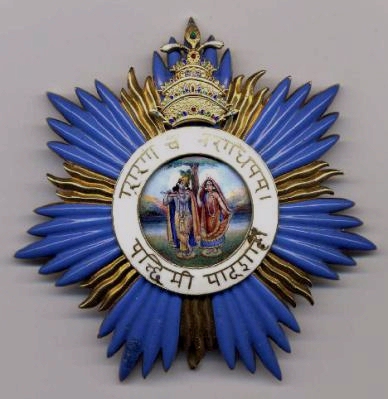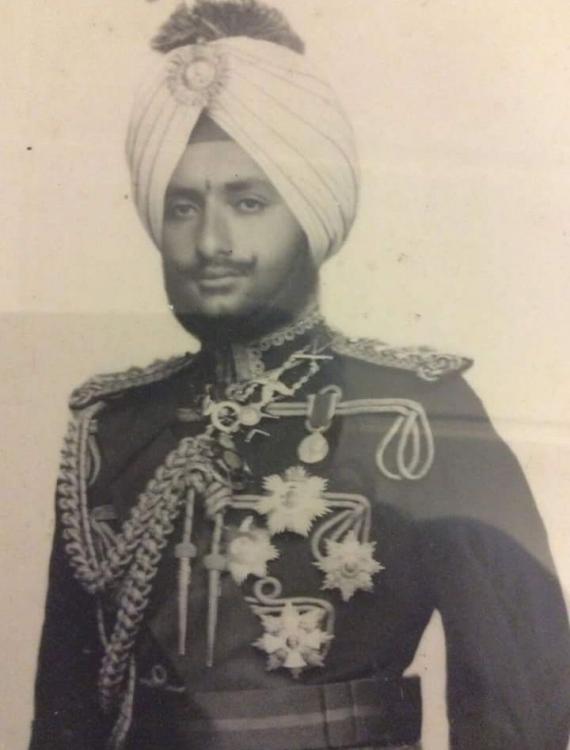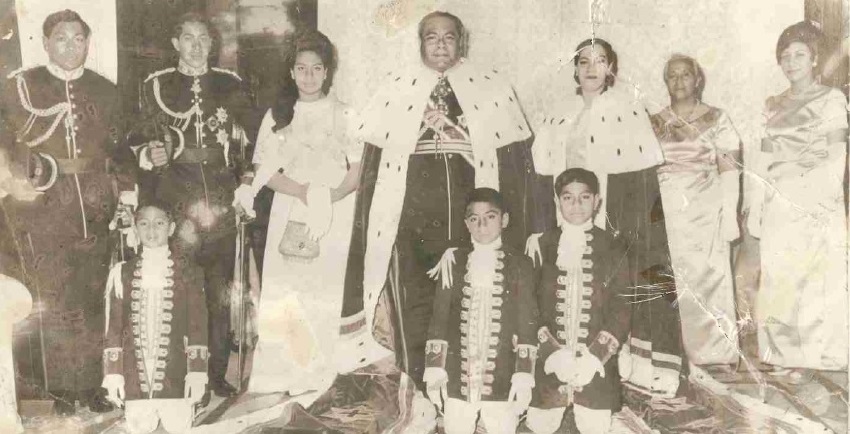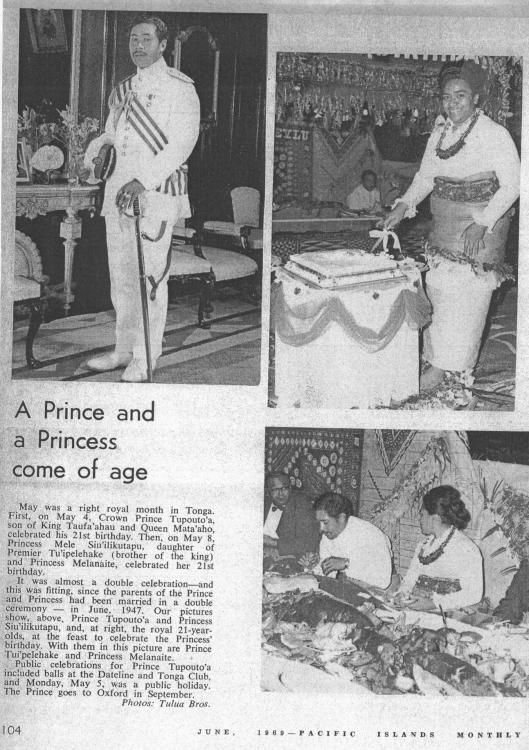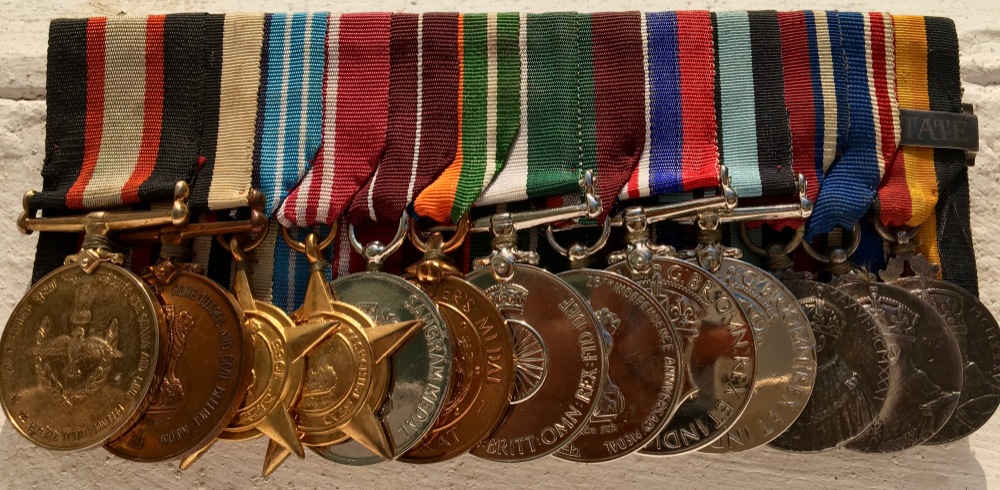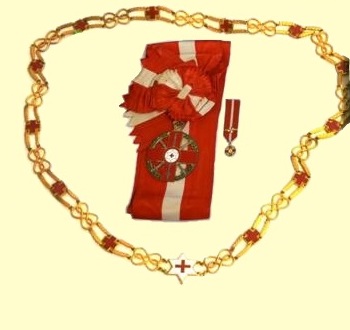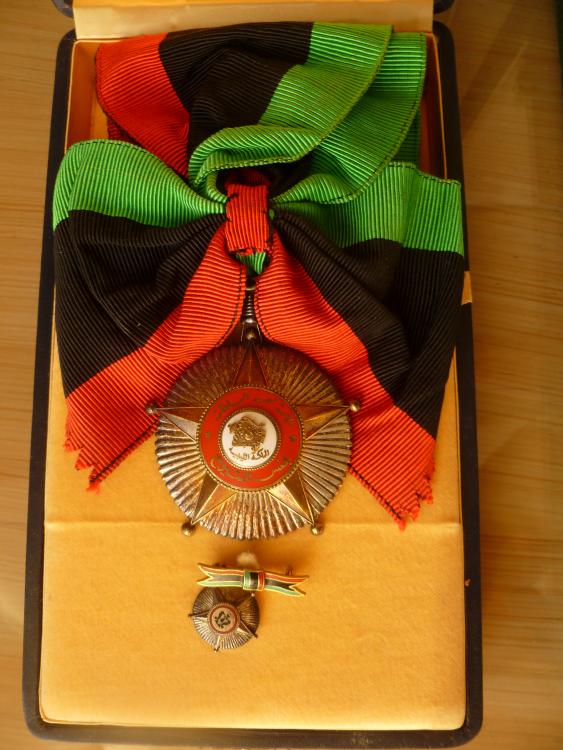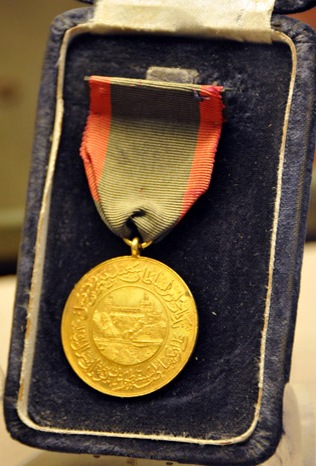
James Hoard
For Deletion-
Posts
632 -
Joined
-
Last visited
-
Days Won
1
James Hoard last won the day on March 10 2011
James Hoard had the most liked content!
Profile Information
-
Location
UK
James Hoard's Achievements
-
Dr Ali Kolahdooz started following James Hoard
-
The Journal des débats politiques et littéraires of 8th September 1935, mentions that H.H. Maharaja Bhupindra Singh of Patiala conferred the Grand Collars of his Orders of Krishna and the Holy Saint on H.M. King Carol II of Romania, and the GC of the Order of the Holy Saint on H.M. Dowager Queen Marie and H.R.H. the Grand Voyvode Michael (later H.M. King Michael). In return, the King conferred the GC of the Order of Faithful Service on the Maharaja, the GC of the Order of the Crown of Romania on the Maharani, and the GC of the Order of the Star of Rumania on Prince Yadavindra Singh. However, a portrait of the young Maharaja Yadavindra Singh from the late 1930's appears to show him wearing the breast star of the GC of the Order of Faithful Service (Serviciul Credincios). Given the evident error over the Order of Faithful Service, I wonder is anybody could confirm the actual award conferred on Maharaja Bhupindra Singh. Did he receive the GC of the Order of the Star of Rumania or some other higher award? Carol I perhaps. [He had previously received the GC of the Order of the Crown at the end of WWI in 1918]. It would also be very useful to have the actual date of these awards. Can anyone identify the slightly skewed, dark enameled Maltese cross, Maharaja Yadavindra Singh is wearing around his neck? Cheers
-
New Order for Tonga
James Hoard replied to James Hoard's topic in Rest of the World: Militaria & History
The Getty picture is misdated. The picture dates from between 1970 and 1977. The then King received the GCVO in 1970 and was promoted to GCMG in 1977. Not sure why the Cr Pr is wearing the 2nd class 7-pointed breast star of the Order of George I, rather than the 8-pointed 1st class breast star. He was prom to the GC at the time he was formally installed as Crown Prince in 1969. There are pictures of him in Pacific Islands Monthly at the time, where he appears wearing the sash and sash badge, the breast star and a chest medal. Unfortunately, the breast star in that picture is indistinct because he is in tropical uniform and the picture was somewhat overexposed so one has nothing to compare. At the time of the Coronation in 1967, the Cr Pr wore the breast starts of three orders, and neck badges of two orders. In senior position, the breast star was 8-pointed. Somewhat akin to the first class of the Order of George Tupou I, but a little indistinct so I cannot be sure what it is. The second breast star was clearly the old version of the Order of the Crown of Tonga - 4-pointed (almost identical to the Prussian order of the same name). In third position the 2nd class, 7-pointed star of the Order of George Tupou I. As for the two neck badges, the first worn at the throat is the 5-pointed badge of the Order of George Tupou I. At the second button hole, the badge is a four armed, white enamelled Geneva cross, with a circular disc in the centre. This is identical to the one in the Getty picture, so I would surmise that the neck badge the Order of the Crown, rather than "Cross of Merit". The second breast star in the Getty picture is almost certainly the Order of the Cross of Tonga, though the name of this order is not a 100% certainty. I am, of late, quite dubious about the existence of a "Cross of Merit". I now suspect that this term has been mistakenly applied to what were junior classes of the Order of the Crown and Order of the Cross of Tonga. Like "Medal of Merit", the term may perhaps be a catch all from the American numismatic world, applied whenever anything unfamiliar cropped up but one didn't want to appear unknowing. I append a copy of the 1967 Coronation picture which depicts the Crown prince wearing the three breast stars and two neck badges of the second class orders he then held. And here, an image of the Pacific Island Monthly 1969, in which the Cr Pr is depicted wearing the GC of the Order of George Tupou I. -
Yes Peter, I am afraid the publication is an academic one. However, for the really interested I thought I would give the full reference in case they had a mind to chase it up.
-
This post is ages late and the thread has morphed since the original post by Megan, but some new information on this that may be relevant. Lij Iyasu, who succeeded Menelik II and was deposed in 1916, instituted several decorations during his brief reign 1913-1916. Unfortunately, very little is know about them. The only one that I have been able to find any information on is the Order of the Lion of Judah. Instituted ca 1914, lapsed 1916. It had either 4 or 5 classes. The badge was very similar to the Order of the Seal of Solomon, based on the Star of David, but with the Ethiopian "Lion of Judah" carrying its cross in it's paw. The only extant example of the GC is the one presented to Friedrich-Wilhelm von Syburg, German Minister at the Court of Iyasu V 1914-1918, now in the collection of Jürgen Otto, who purchased it from the estate of Syburg's childless son. The insignia are depicted on page 72 of Wolbert G.C. Smidt, “Photos as Historical Witnesses: The First Ethiopians in Germany and the First Germans in Ethiopia, the History of a Complex Relationship (Afrika Visuell Book 2)”. LIT Verlag (Mul edition), 2015. ISBN-13: 978-3643101952; ISBN-10: 3643101953. The breast star is often seen in old photographs of senior noblemen and officials who survived the Iyasu era into the early years of the reign of Haile Selassie I, but usually misidentified as the Order of Solomon. However, the tell tale signs are that the Judah star's points are a little elongated and usually worn in a relatively junior position. See the portrait of H.E. Bitwodad Makonnen Demissie attached. The riband appears to have been worn over the left shoulder, with the badge resting on the right hip. The colour must have been red or crimson (the extant sash is now faded to a sort of soft pink). I also seem to vaguely remember a blue stripe, but cannot now recall if it went down the centre or towards each edge. To my horror I had a good image of this same insignia for several years, then foolishly deleted it sometime later believing the decoration to be a fantasy. The best I can now find is a lower class (4th or 5th) - attached below. I am afraid that the "Crown Council" came up with the new creation (depicted above by Megen) for the US and Iberian gong-hunting market, completely misunderstanding the history of the Order of the Lion of Judah. Most likely the title of "Ethiopian Lion" comes from a misreading of a German reference. Their website speaks of the order being derived from the Order of Emperor Menelik II and a good deal of other eye wash.
-
Indian Princely States - Idar State Georve V Jubilee Medal?
James Hoard replied to James Hoard's topic in South Asia
-
Indian Princely States - Idar State Georve V Jubilee Medal?
James Hoard replied to James Hoard's topic in South Asia
I do have some other pictures Paul, I am just waiting for the grandson's permission to publish them. They are not ideal, because the ribbons are tightly stitched to one another, but he has turned it over sideways and photographed the medal obverse and reverse at 90 degrees. The picclick website does have another of these medals, but the suspension is quite different from the Idar version and without ribbon or any other clues I do not know who the issuing authority was. http://picclick.co.uk/GB-1935-Silver-Jubilee-King-George-V-142070533218.html -
Indian Princely States - Idar State Georve V Jubilee Medal?
James Hoard posted a topic in South Asia
I have been sent the following image of an Indian medal bar by the grandson of the recipient, a former Captain in the Idar State Forces who served in WWII and later Honorary Commandant of the Home Guard in the state of Gujarat. The last medal in the group is what interests me. Unfortunately, I do not yet have his permission to publish larger images of it but close-up analysis seems to show the medal, mounted for wear, with a distinctive ribbon and an "Idar State" clasp, but otherwise identical to the George V Jubilee Medal 1910-1935 illustrated in this article - http://www.thamesweb.co.uk/windsor/memorials/geov_medal.html Can anybody shed more light on this state award, if that is what it is? Cheers. -
Hawaii - medals
James Hoard replied to James Hoard's topic in Rest of the World: Militaria & History
That's it - the World Tour Medal: "Maltese cross made of stainless steel, with central medallion made as revolving terrestrial globe of ceramics with marking of the around-the-world Royal Tour 1881. The cross is surmounted with a steel riband knotted and engraved 1874-1881." Number 5 is definitely not Hawaiian, the crown is continental European. Your medal is the actual so-called Coat of Arms Medal: "Size is 55 mm, gold and brass, in the shape of a sanded Maltese cross with polished edges. Central medallion is circular and charged in obverse with Hawaiian Greater Coat of Arms." Please see Dragomir's post on the previous page. Cheers. -
New Order for Tonga
James Hoard replied to James Hoard's topic in Rest of the World: Militaria & History
I am not really sure anymore if the insignia as designed by Worth was necessarily the same as that eventually produced and conferred. The present King does not seem to wear any orders and decorations, other than those physically invested upon him. So I suspect that the Royal Household Star was the one given to him by his late brother in August 2011, and not a new design or creation. I have not seen any pictures of anyone else who has received the same class of decoration wearing a GC breast star the same as the original Worth design. It seems that several other proposals for orders and decorations proposed by Worth were either not accepted or not acted upon. So the Tongans may well have gone their own way after the submission of designs, based on what the actually manufacturers could provide, cost constraints, etc. There does not appear to be any evidence for a change in riband colour for the Order of Queen Salote. To add a little more into the heady mix of Tongan orders. Here is what is believed to be the Order of the Tongan Star conferred on Neville Packett - Grand Cross collar, sash, sash badge and miniature. Copyright Christopher Buyers Cheers. -
Libya - unknown order and medal
James Hoard replied to James Hoard's topic in Middle East & Arab States
Thank you everyone for all your useful comments and valuable ideas. Apologies for not replying earlier but I have had a lot of trouble logging into my account. Eventually managed it today by ignoring everything and logging-in anonymously via Facebook. The Libyan decoration would, I imagine, be a first class decoration of the President of the Divan Owain, as regards the Sultan Saeed of Oman Medal. He succeeded on his father's abdication 10th February 1932, which corresponds to 2nd Shawwal 1350 (sic) not 1351. So could this medal have been issued to commemorate the first anniversary? Unfortunately the image is as received. So I do not have anything larger and cannot really say if the play of museum lights is giving it a golden glow or not. I would "imagine" not, because the white border within the case is fairly white, as is the gloved hand holding it. Cheers -
Hawaii - medals
James Hoard replied to James Hoard's topic in Rest of the World: Militaria & History
That's very interesting. I am actually more interested in the picture of the King and his medal bar! There seem to be several decorations that are not easily unidentifiable, and could be other Hawaiian decorations hitherto not mentioned in texts I have seen. The first on his medal bar looks to be his badge of the Order of Carlos III of Spain (received 1881), number 2 looks like either the North Star of Sweden (received 1884) or Vasa of Sweden (received 1881), and number 7 appears to be the Dannebrog of Denmark (received 1880). Number 5 with a "continental" crown may be another one of the many foreign orders he received. However, numbers 3, 4, 6, and 8 may be Hawaiian. Number 6 also looks very much like your "Holo Hana Cross" but the ribbon is clearly different. Whether number 6 is actually the same as the "Holo Hana Cross" mentioned elsewhere is open to a little doubt, because the description I have seen mentions a "fire chief trumpet" and a ribbon of 2 red and 2 yellow stripes. Number 4 may well be the so-called "Coat of Arms" medal. This is mentioned by Adrienne Lois Kaeppler in Bernice P. Bishop Museum Special Publication, Volumes 65-67, Bishop Museum Press, 1978, p 210. Also mentioned in Roger G. Rose, Hawaiʻi, the Royal Isles, Bishop Museum Press, 1980, pp 145 and 210. Both are available in snippet view on google books, but I cannot view the images so cannot verify if they are the same. Would be very useful to find a larger and clearer version of the King's picture. -
I have been sent the attached image for identification, but have no idea what they are. The order on the sash seems quite genuine, as it belonged to Dr Abdusselam bin Abdurrahman Al Busairi, a recognised national hero who was imprisoned by the Italian Fascists 1923-1933, released and exiled to Ankara in 1933, employed by the Turkish Foreign office until recalled by King Idris to Libya in 1954 and appointed as the Foreign Affairs Minister, then served as President of the Divan 1955, Ambassador to the UK and the Benelux Courts (concurrently) and subsequently to Turkey 1964-1969. Among his other decorations are the Libpyan Order of Independence (Wisam al-Istiqlal ) first class, and the Egyptian Order of the Republic first class. Any help in identifying this decoration, much appreciated. A further Libyan Medal about which I hope some member will be able to provide some details. One suggestion is that this is called the Medal of Resistance Against Colonialism, but I do not know if this is correct or what era it dates from. Cheers
-
Albania- Wied era medals
James Hoard replied to James Hoard's topic in Southern European & Balkan States
Bob, that's the Romanov Tercentenary Medal 1913. http://antique-photos.com/en/awardsdatabase/russian-empire/539-sommemorative-medal-for-the-tercentenary-of-the-romanov-dynasty.html Cheers






